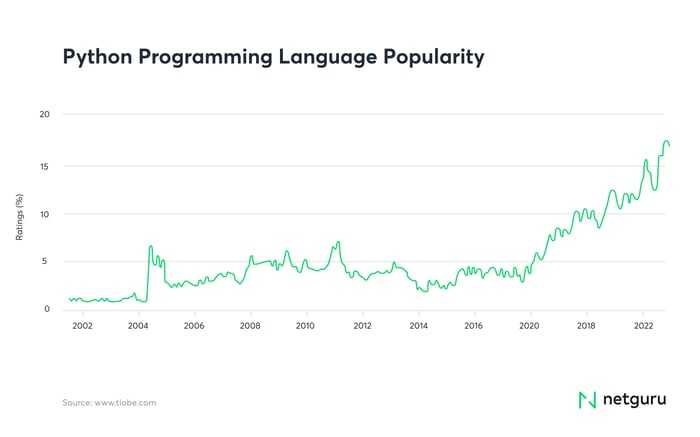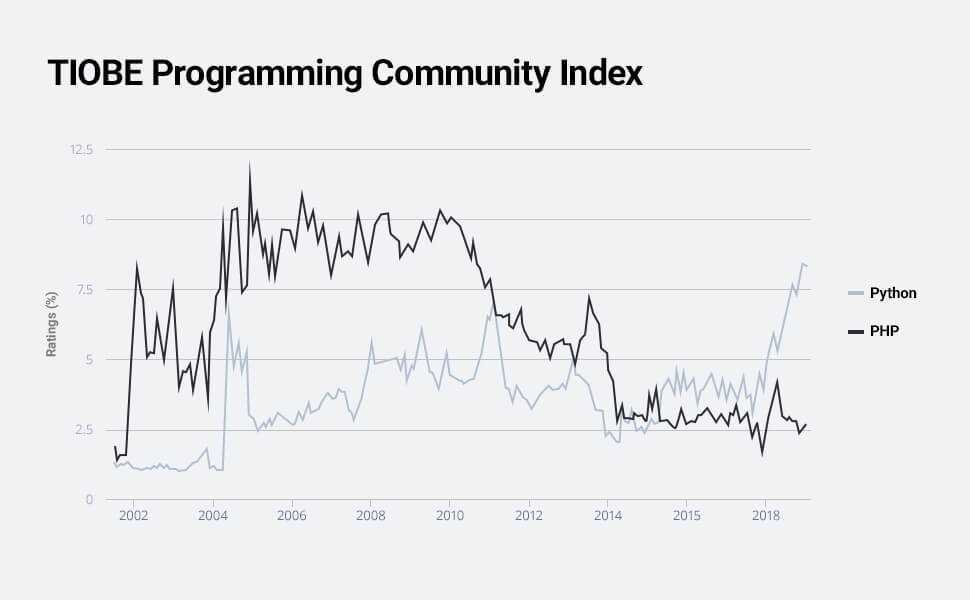Why is Python one of the most popular programming languages for software development?
Python is a dynamic and versatile programming language that’s been used for software development for over 30 years. Indeed, it’s currently ranked number one in the
TIOBE Index, measuring the popularity of programming languages. Moreover, TIOBE ranked Python language of the year in 2007, 2010, 2018, 2020, and 2021.

Source:
TIOBE
The following reasons are cited for developing Python applications, web apps, and machine learning models:
- Python builds simple and complex apps easily. Any kind of business can use Python, which is why it’s used by startups and multi-billion dollar corporations alike.
-
Python has powerful data science capabilities.
Python performs better than R for data manipulation and repetitive tasks, which is why it’s often used for artificial intelligence solutions and machine learning applications.
Exceptional productivity. Python is relatively easy to write, read, and learn, enabling software engineers to build products efficiently.
Large and vibrant community. Python is one of the most widespread coding languages today, with a
community of around 15.7 million, second only to JavaScript. Developers create and share tools and knowledge for others to benefit from.
Versatile and efficient functionality. Python is known for being one of the most versatile technologies. It can be used across multiple industries and spans web applications, software development, audio and video applications, gaming, and AI.
Ready-to-use solutions. The programming language offers over
137,000 open-source libraries and an array of powerful Python frameworks, so there’s access to many functionalities, speeding up the development process.
Easy integrations. Python is called a “glue language” because it’s easy to integrate with other components such as languages, web frameworks, external services, and existing infrastructure elements.
Stable and secure. Because of its simple syntax and readability, Python has developed a reputation as a secure technology, making it a top choice for financial applications dealing with sensitive data.
Python is scalable, allowing software developers to grow (or downsize) applications with ease, particularly when using the Django backend framework.
Скриптинг
Что такое скриптинг?
Скриптинг обычно используется при написании небольших программ для автоматизации простых задач. Позвольте мне привести пример из личного опыта:
Когда-то я работал в небольшом стартапе в Японии, в котором у нас была система поддержки электронной почты. Эта система нужна была нам для того, чтобы мы отвечали на всевозможные вопросы клиентов. И пока я там работал, мне приходилось подсчитывать количество писем, содержащих определенные ключевые слова, чтобы затем мы могли анализировать полученные письма.
Мы могли бы делать это вручную, но вместо этого я написал простой скрипт для автоматизации этой задачи.
В то время, для написания скрипта я использовал Ruby, однако Python также прекрасно подойдет для решения подобного рода задач. В данном случае его основным преимуществом перед Ruby будет простой синтаксис и скорость работы: вы можете быстро написать небольшой скрипт и протестировать его работу.
Что насчет встраиваемых систем?
Я не специалист по встраиваемым системам, но я точно знаю, что Python отлично работает с Rasberry Pi и пользуется популярность среди любителей подобного аппаратного обеспечения.
А как насчет разработки игр?
Вы можете использовать библиотеку PyGame для разработки игр, однако на практике ей пользуются не так уж часто. PyGame подойдет, если вы занимаетесь разработкой игр в качестве хобби или для создания небольшого проекта. Лично я бы не стал разрабатывать серьезный проект на ее основе.
Скорее, я бы рекомендовал вам начать с Unity на языке C #. Движок Unityявляется одним из самых популярных игровых движков в мире — это позволяет вам создавать игры для всех основных платформ, включая Mac, Windows, iOS и Android.
Что насчет приложений для ПК?
Вы можете писать приложения на Python для ПК, используя библиотеку Tkinter, однако это не самый популярный способ.
На сегодняшний день, для написания приложений для ПК, гораздо чаще используют такие языки, как Java, C # и C ++ . Совсем недавно, некоторые компании начали использовать JavaScript в качестве основного языка разработки.
Например, настольное приложение Slack было создано с помощью фреймворка Electron — который позволяет разрабатывать нативные графические приложения для настольных операционных систем с помощью веб-технологий.
Если бы мне пришлось писать приложение для ПК, то лично я бы использовал JavaScript — это позволило бы мне повторно использовать код из веб-версии. Тем не менее, я не специалист в разработке настольных приложений.
Разница между back-end и front-end кодом (на тот случай, если вы не можете в этом разобраться):
Предположим, вы хотите создать свой собственный проект — что-то вроде Instagram.
Сначала, вам придется написать frontend код для каждого типа устройств и ОС, которые вы будете поддерживать. Для этого вы можете использовать, например:
- Swift для iOS
- Java для Android
- JavaScript для веб-браузеров
Каждый из наборов кода будет использоваться в зависимости от используемого устройства или браузера. Он будет определять компоновку дизайна, как должны выглядеть кнопки при нажатии на них и т. д. То есть front-end код будет определять все, что касается графического интерфейса приложения.
Затем вам нужно позаботиться о возможности хранения информации и фотографий пользователей на своих серверах. Иначе пользователи просто не смогут просматривать фотографии и информацию других пользователей.
Вот здесь то нам и нужен back-end / server-side код. Вам нужно будет написать backend код, для возможности выполнения подобных операций:
- Обрабатывать: кто на кого подписался и кому поставил лайк
- Сжимать фотографии пользователей, чтобы они не занимали слишком много места на ваших серверах
- Рекомендовать пользователям фотографии других пользователей и т. д.
Проще говоря, front-end код нужен для создания дизайна и интерфейса приложения или сайта. А back-end код обеспечивает взаимодействие с сервером. В этом и заключается разница между frontend и backend кодом.
Кстати, Python — не единственный хороший вариант для написания backend / server-side кода. Есть много других популярных и неплохих вариантов, которые вы можете использовать, включая Node.js, который основан на JavaScript.
Понравилась ли вам эта статья? Возможно, вам также понравится мой Youtube канал
У меня есть канал обучения программированию на YouTube, который называется CS Dojo с 440 000 + подписчиками, где я регулярно выпускаю качественный контент.
Например, вам могут понравиться эти видеоролики:
Перевод статьи YK SugiWhat exactly can you do with Python? Here are Python’s 3 main applications
Где используется Python
Python широко распространен во многих сферах: от системного администрирования до Data Science.
Системное администрирование
Системным администраторам Python нужен для автоматизации задач. Он простой, мощный и поддерживает специальные пакеты, которые повышают его эффективность. И, самое главное, он по умолчанию установлен на все серверы с ОС Linux.
Благодаря лаконичности Python можно быстро прочитать код и найти слабые места. Форматирование в языке — часть синтаксиса.
Научные исследования
В Python есть несколько библиотек, которые пригодятся для проведения исследований и вычислений:
Благодаря библиотекам и простоте освоения языка многие учёные выбирают Python — особенно он популярен у математиков и физиков.
Data Science
Python — один из самых используемых в Data Science языков. На нём пишут алгоритмы программ с машинным обучением и аналитические приложения. С помощью него обслуживают хранилища данных и облачные сервисы.
Также он помогает парсить данные из интернета. Например, в Google Python применяют для индексации сайтов.
Real-world Examples of Python in Web Development
Python is undoubtedly a very popular programming language, and web development projects in Python can significantly help to improve your resume as it is widely used in almost every organization in the world. To learn more about Python with web development projects for beginners, consider registering for the Web Design online course by KnowledgeHut.
Here are some real-world examples of Python projects on web development. These include some of the most famous names that people tend to use all the time, without realizing that they are actually using Python-based websites and applications:
1. Netflix
Netflix is one of the most renowned entertainment applications for benching movies and web series. Netflix is one of the biggest pieces of evidence of digital change and transformation, which incorporates Python in its creation and maintenance. The most used streaming service in the world is a result of web development projects using Python.
Python programming language has a major share in the success of building a popular web application like Netflix. Netflix’s web developers themselves said that Python is used in the full development cycle of the application and also for maintaining the application. Python is greatly used for maintaining the security of Netflix and running its various applications. The in-house content distribution network of Netflix, Open Connect, is also set up with the help of Python, and end users can watch whatever they want to without any hindrance.
2. Reddit
The World is not unaware of the impact that Reddit created on the internet and its transformation, but what most people don’t know is that Reddit has also been coded in Python programming language. Reddit has been the mainstay of the global internal diet for a very long time as it is a go-to website for reading recent news, cutting-edge social talks, and almost everything else.
Reddit uses Python programming to translate the requests of the users that have been sent to the Reddit browser. Python works with the request of the user and then sends the required HTML that is displayed on the screens of the users. Even though the users can’t see how Python functions with Reddit, it is still there, and Python is inseparable from the application.
3. Spotify
Spotify is the one-step application when you want to listen to your favorite playlist. Spotify has made searching and listening to music so much easier when compared to the old CD and DVD days. It provides hassle-free and fast services, and the application is built heavily with Python programming language.
The entire back-end development of Spotify is based on Python, as it provides interconnected services for a better user experience. It has been remarked by the web developers of Spotify that almost 80% of the application is developed through coding in Python. Spotify is a phenomenal example of a Python project for web development that has proven to be immensely successful in recent times.
Additionally, Spotify offers a customized data analytics program called Luigi. Luigi is responsible for driving Spotify’s Radio and Discover features and making suggestions for people the users might like to follow. This application was created to swiftly prototype complex data operations.
Falcon
Это микро-фреймворк, используемый для создания веб-API, и еще один широко используемый фреймворк Python. Он требует множества зависимостей для создания HTTP API и позволяет разработчику создать более понятный дизайн, допускающий архитектуру HTTP и REST.
Falcon широко используется в таких крупных организациях, как LinkedIn, OpenStack и RackSpace. Он может обрабатывать больше запросов на одном и том же оборудовании, чем все его современники. Эта структура ориентирована на 100% покрытие кода.
Ключевые особенности Falcon:
- Предварительная обработка исключений.
- Может обеспечить дополнительную скорость с поддержкой Cython.
- Имеет сильно оптимизированную базу кода, а также расширяемый.
- Модульное тестирование с помощью помощника WSGI и макетов.
- Его классы запросов и ответов обеспечивают легкий доступ к заголовкам и объектам.
- Собственные ответы на ошибки HTTP.
Недостатки языка Python
Несмотря на все достоинства, у языка есть и недостатки.
Программы на Python считаются одними из самых медленных.
Приложения для iOS на Swift работают в 8,7 раз быстрее, чем на Python. Реализация PyPy по скорости близка к Java, но в ней есть не все возможности оригинального языка. Python не подходит для задач, требующих большого объёма памяти, — их лучше решать вставками на C или C++.
Сильная зависимость языка от системных библиотек
Из-за этого затрудняется перенос на другие системы. Для этих целей существует инструмент Virtualenv, но и он с недостатками: избыточность полных методов изоляции, костыли, дублирование системных библиотек.
Global Interpreter Lock (GIL) не позволяет выполнять несколько потоков Python одновременно в реализации CPython.
Однако GIL можно отключить на какое-то время, как это сделано в математическом пакете NumPy.
Трудоустройство и средняя зарплата Python-разработчика
По данным с hh.ru на начало 2019 года, в России
4500 вакансий для Python-разработчиков, из них
700 в Санкт-Петербурге. Это меньше, чем по запросу «Java» (
5500), но больше, чем по запросу «PHP» (
Тенденция в том, что Python медленно забирает позиции PHP с рынка веб-разработки. Хотя на PHP всё ещё написано около 80% всех сайтов в интернете.

Минимальная зарплата по России начинается с 70 000 рублей, а в Москве — с 80 000 рублей. В основном ищут опытных разработчиков, junior-специалисты менее востребованы.
На должность стажёра или младшего специалиста можно устроиться только в крупную компанию, а расположены они в больших городах типа Москвы и Санкт-Петербурга. Из-за этого новичкам крайне сложно устроиться в регионах — остаётся искать заказы на фрилансе.
Если вас заинтересовал Python, пройдите курс от Skillbox — тут вы не только получите необходимые знания и навыки, но и сможете составить привлекательное резюме и добавить дипломную работу в портфолио.
Netflix
Netflix — это популярный потоковый сервис на основе подписки, который обеспечит онлайн-трансляцию фильмов, сериалов, телепрограмм и т.д. Это один из самых известных сайтов, написанных на Python.
Одной из сильных сторон Netflix является его мощный механизм рекомендаций и аналитики, позволяющий компании не только давать вам рекомендации, но и предсказывать, какой именно контент им следует заказать.

То, что Spotify сделал для музыки, Netflix сделал для фильмов и сериалов. Стартовав как компания которая предоставляет службу рассылки DVD по почте, сегодня Netflix является лидером в области высоких технологий, предоставляя потоковый видео контент сотням миллионов подписчиков.
Одно из основных систем, где используется Python, — это центральный шлюз оповещений. Это RESTful веб-приложение, которое обрабатывает предупреждения из любого места, а затем направляет их людям или группам, которым необходимо их увидеть. Кроме того, приложение имеет возможность ограничивать повторяющиеся предупреждения, которые уже были обработаны, и в некоторых случаях выполнять автоматические решения, такие как перезагрузка процесса или завершение чего-то, что начинает работать нестабильно.
Сеть доставки контента для Netflix — Open Connect. CDN написан на Python. Сетевые устройства, составляющие огромную часть CDN, в основном тоже управляются приложениями на Python. Кроме того, поскольку язык прост в разработке, он стал стержнем во многих других сервисах Netflix.
Comparison with competitors
Netflix currently competes with two major players: Hulu and Amazon Prime Video.
1. Netflix and Hulu
Both Netflix and Hulu are compatible with most modern smartphones and tablets. Even the interface of both these services is user-friendly. Some features make Netflix a slightly better option in terms of usability. For example, it has a closed-captioning option for its content since 2014. The parental control of this service is also more robust.
The users can enjoy Dolby Atmos soundtracks for some of the content by Netflix, something you can’t expect with Hulu. Talking about the content, with an investment of more than 13 billion dollars per year on content, Netflix is way ahead of its competitors.
2. Netflix and Amazon Prime
Compared to Amazon Prime Video, Netflix has consistent interfaces in most of the devices it is compatible with. A single member can have multiple user profiles on Netflix, something we have already discussed above. Each profile gets its own set of recommendations.
A unique feature associated with Netflix is its Smart Downloads feature that automatically removes the episodes that a user has already watched. Once the Wi-Fi connection is available, it automatically downloads the subsequent episode, something not available with Amazon Prime Video. The reactive/responsive search of Netflix makes it easier for the users to locate the content they are seeking quickly. A lot of users feel that Search option of Amazon Prime is a little bit cumbersome.
A particular functionality where Amazon scores extra is its X-Ray feature. A user can access bios, soundtrack info, trivia, and cast photos, without leaving the playback screen. Netflix is yet to introduce something like this.
What lies ahead?
The team at Netflix is working on making the experience more personalized. It is currently testing the functionality of personalized tags and text descriptions. The technology related to movie recommendations is also being evolved regularly. It is also possible that many mobile devices will let the users view interactive films seamlessly, a feature currently limited to only a few devices.
TechAhead, a leading mobile application development company is known to deliver high quality mobile apps for all platforms and frameworks. Contact our experts now to take your business to the next level.
Step 4: Preparing the Data for Analysis
Before we can do our number-crunching, let’s clean up this data a bit to make it easier to work with.
Dropping Unnecessary Columns (Optional)
First, we’ll start by dropping the columns we’re not planning to use. This is totally optional, and it’s probably not a good idea for large-scale or ongoing projects. But for a small-scale personal project like this, it can be nice to work with a dataframe that includes only columns we’re actually using.
In this case, we’re planning to analyze how much and when I’ve watched The Office, so we’ll need to keep the , , and columns. Everything else can go.
To do this, we’ll use and pass it two arguments:
- A list of the columns we’d like to drop
- , which tells pandas to drop columns
Here’s what it looks like:
| Start Time | Duration | Title | |
|---|---|---|---|
| 2020-10-29 3:27:48 | 0:00:02 | The Office (U.S.): Season 7: Ultimatum (Episod… |
Great! Next, let’s work with the time data.
Converting Strings to Datetime and Timedelta in Pandas
The data in our two time-related columns certainly looks correct, but what format is this data actually being stored in? We can use to get a quick list of the data types for each column in our dataframe:
As we can see here, all three columns are stored as , which means they’re strings. That’s fine for the column, but we need to change the two time-related columns into the correct datatypes before we can work with them.
Specifically, we need to do the following:
- Convert to datetime (a data and time format pandas can understand and perform calculations with)
- Convert from UTC to our local timezone
- Convert to timedelta (a time duration format pandas can understand and perform calculations with)
So, let’s approach those tasks in that order, starting with converting to datetime using pandas’s .
We’ll also add the optional argument so that our datetime data has the UTC timezone attached to it. This is important, since we’ll need to convert it to a different timezone in the next step.
We’ll then run again just to confirm that this has worked as expected.
Now we’ve got that column in the correct format, it’s time to change the timezone so that when we do our analysis, we’ll see everything in local time.
We can convert datetimes to any timezone using the and passing it an argument with the string for the timezone we want to convert to. In this case, that’s . To find your specific timezone, here’s a handy reference of TZ timezone options.
The tricky bit here is that we can only use on a DatetimeIndex, so we need to set our column as the index using before we perform the conversion.
In this tutorial, we’ll then use to turn it back into a regular column afterwards. Depending on your preference and goals, this may not be necessary, but for the purposes of simplicity here, we’ll try to do our analysis with all of our data in columns rather than having some of it as the index.
Putting all of that together looks like this:
| Start Time | Duration | Title | |
|---|---|---|---|
| 2020-10-28 23:27:48-04:00 | 0:00:02 | The Office (U.S.): Season 7: Ultimatum (Episod… |
We can see this is correct because the previous first row in our dataset had a of . During Daylight Savings Time, the U.S. Eastern time zone is four hours behind UTC, so we can see that our conversion has happened correctly!
Now, let’s deal with our column. This is, as the name suggests, a duration — a measure of a length of time. So, rather than converting it to a datetime, we need to convert it to a timedelta, which is a measure of time duration that pandas understands.
This is very similar to what we did when converting the column. We’ll just need to use and pass it the column we want to convert as an argument.
Once again, we’ll use to quickly check our work.
Perfect! But we’ve got one more data preparation task to handle: filtering that column so that we can analyze only views of The Office.
Filtering Strings by Substring in pandas Using str.contains
There are many ways we could approach filtering The Office views. For our purposes here, though, we’re going to create a new dataframe called and populate it only with rows where the column contains .
We can do this using , giving it two arguments:
- , which is the substring we’re using to pick out only episodes of The Office.
- , which tells the function that the previous argument is a string and not a regular expression.
Here’s what it looks like in practice:
Once we’ve done this, there are a few ways we could double-check our work. For example, we could use to inspect a random ten rows of our new dataframe. If all twenty rows contained Office episodes, we could be pretty confident things worked as expected.
For the purposes of preserving a little privacy in this tutorial, though, I’ll run to check the size of the new dataframe. Since this dataframe should contain only my views of The Office, we should expect it to have significantly fewer rows than the 27,000+ row dataset.
Sanic
Sanic – это веб-фреймворк, построенный на uvloop. Он предоставляет одну из лучших функций, то есть предлагает быстрые HTTP-ответы через асинхронную обработку запросов. Он предоставляет неблокирующие возможности, повышающие скорость. Более того, он поддерживает обработку запросов и сравнивает их с функциями await / async Python 3.5.
Ключевые особенности Sanic:
- Представления на основе классов.
- Подключаемая опора.
- Возможность чтения и записи файлов cookie.
- Позволяет вести различные типы журналов, например журналы ошибок и журналы доступа.
- Наличие обработчиков с удобной поддержкой декораторов.
When to use Python: web development and data science projects
Since Python is a high-level and universal programming language, it’s widely used – as the examples above show. How else can the Python programming language be applied?
-
Data Science: Python allows you to quickly manipulate and analyze data, and graphing libraries are easily available to support data visualization. There’s also a vibrant Python data science community.
-
Python application development:As a general-purpose language, Python is useful for developing file directories, desktop GUIs, and APIs.
-
Web development:
Python frameworks such as Django and Flaskare popular choices for web development. Furthermore, Python’s extensive libraries and modules speed up development time.
- Game development: Python libraries such as Pygame are useful for building prototypes and games. Indeed, EVE Online, Battlefield 2, and World of Tanks were built using Python.
- Web scraping applications: If you need to quickly extract large amounts of data from a website for price comparisons, email address gathering, or research and development, Python facilitates that. How? It’s simple to code, has a collection of useful libraries like Numpy, Matlplotlib, and Pandas, and boasts an easily understandable syntax.
What’s Next?
In this tutorial, we’ve taken a quick dive into some personal Netflix data and learned that — among other things — I watch The Office too much. But there are tons of places you could go from here! Here are some ideas for expanding this project for yourself:
- Do the same or similar analysis for another show.
- See if you can create separate columns for show titles and episode titles using regular expressions [learn to use those in our Advanced Data Cleaning course)
- Figure out which specific episodes you’ve watched most and least
- Create prettier charts (our Storytelling with Data Visualization course can help with that)

When you realize your Netflix viewing habits have led to you finishing a cool project.
You can also try out some other fun projects using your own personal data. For example:
- Use Python to find out how much you’ve spent on Amazon
- Use Python to analyze your Facebook posting habits
Want to learn to do this kind of project on your own, whenever you want? Our interactive data science courses will teach you to do all of this — and a whole lot more! — right in your browser window.












![8 top python web app examples from top-notch companies [2023 update]](http://triathlon21.ru/wp-content/uploads/9/2/4/924d61b16b99e2da7167c281c59f2320.webp)
![Top 18 python web development projects in 2024 [source code]](http://triathlon21.ru/wp-content/uploads/9/6/6/966c110a30f5d7e2f9883f6061ca8068.jpeg)










